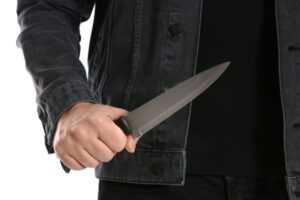

 Being charged with assault with a deadly weapon in California is a major issue, and Summit Defense understands that. A mere criminal charge can be incredibly stressful; however, a conviction, regardless of whether it is a misdemeanor or a felony, can change your life forever.
Being charged with assault with a deadly weapon in California is a major issue, and Summit Defense understands that. A mere criminal charge can be incredibly stressful; however, a conviction, regardless of whether it is a misdemeanor or a felony, can change your life forever.
Next, we'll break down what you need to know about this charge and how our defense team can protect your rights. Then, contact us for a free case consultation.
The complexity of assault with deadly weapon charges requires a clear familiarity with California law. Let's examine the key elements that make up this offense.
Under California Penal Code Section 245(a)(1), assault with a deadly weapon happens when someone tries to use force against another person with a deadly weapon or with force that could cause great bodily injury. The law states that you must have acted willfully and had the present ability to apply this force.
For instance, imagine you're arguing with someone, and you swing a baseball bat at them. Even if you miss, you could be charged with assault with a deadly weapon. The act of swinging the bat shows both intent and ability to harm with potentially deadly force.
A criminal case needs proof beyond a reasonable doubt. The prosecutor must show you had the means and intent to harm someone with an object that qualifies as a deadly weapon. The California criminal jury instructions define this as an aggravated assault that goes beyond simple assault.
To find a defendant guilty of this crime, the prosecutor has to show proof beyond a reasonable doubt. A reasonable person must recognize that the actions would directly lead to applying force with a lethal weapon.
Police officers often document signs of physical contact or threatening manner in these cases. This helps establish the elements needed for either a misdemeanor or felony offense charge.
California law takes a broad view of what counts as a deadly weapon in assault cases. This definition goes far beyond guns and knives.
A deadly weapon includes any object used in a way that could cause great bodily injury. This means common items like rocks, bottles, or tools can become deadly weapons based on how someone uses them. Even a motor vehicle counts when used to try to harm another person.
Real cases show surprising items classified as deadly weapons. Courts have ruled that steel-toed boots in a kicking attack or a pencil aimed at someone's eye qualify. The key factor isn't just what the object is but how someone uses it to try to harm another person.
The law focuses on the object's potential to cause substantial physical injury in a specific situation. A coffee cup might not typically be dangerous, but throwing it at someone's head could make it a deadly weapon.
Many items are classified as deadly weapons based on their use in a threatening manner. This includes cases where someone tries to remove a police officer's gun during her duties. Courts look at whether a reasonable person would view the object as capable of producing great bodily injury.
Assault weapons and semi-automatic firearms always qualify as deadly weapons at both state and federal levels. But everyday objects used to apply force can also lead to aggravated assault charges.
In California, assault with a deadly weapon is a "wobbler" offense. This means the prosecutor gets to decide whether to charge it as a misdemeanor (less serious) or a felony (more serious). Several factors guide this decision. Prosecutors look at the type of weapon, the level of force used, and any injuries to the alleged victim. A criminal record can lead to more serious charges.
The most serious cases often involve firearms or weapons that cause actual injury. Less severe cases might involve objects that could have caused harm but didn't. The prosecutor's choice between misdemeanor and felony charges can dramatically affect potential penalties and your future.
A misdemeanor (Assault with a Deadly Weapon) ADW conviction carries less severe penalties than a felony one. Still, both create a criminal record. When deciding the charge level, the prosecutor considers whether the defendant acted in a way that produced great bodily injury. Excessive force often pushes cases toward felony status, including situations with imminent danger to the alleged victim's life.
 Some circumstances make felony charges more likely in assault with a deadly weapon case. Knowing these factors helps you grasp the seriousness of your situation.
Some circumstances make felony charges more likely in assault with a deadly weapon case. Knowing these factors helps you grasp the seriousness of your situation.
Cases involving assault weapon violations or attacks on a police officer while on duty typically face felony charges. The law treats these examples as particularly grievous cases deserving of stricter punishment.
Cases involving firearms almost always lead to felony charges under California law. The presence of a gun during an assault creates a presumption of deadly force.
Using a semi-automatic firearm or machine gun brings enhanced penalties. Even pointing an unloaded gun at someone can result in felony charges because of the fear and risk involved.
Other weapons like large knives, brass knuckles, or dangerous animals also increase the chances of felony charges. Prosecutors view these weapons as inherently dangerous and capable of causing great bodily harm.
Related offenses might include charges for possessing prohibited weapons. Firearms are deadly weapons, and an assault case involving them can lead to county jail or California state prison time, depending on circumstances.
The extent of physical harm to the alleged victim strongly influences charging decisions in assault cases. Serious injuries like deep cuts, broken bones, or head trauma point toward felony charges.
California law defines great bodily injury as significant physical harm beyond minor wounds. Examples include:
These injuries show the deadly potential of the weapon used and support felony prosecution.
Your past criminal record weighs heavily in assault with a deadly weapon case. Prior violent crime convictions make felony charges more likely.
The three strikes law can also come into play, potentially increasing prison time. Prosecutors often cite past offenses as proof that you pose an ongoing threat to public safety.
A clean record might help you avoid felony charges, but the nature of the assault still matters most. In contrast, a violent felony conviction for assault with a deadly weapon impacts future cases, too. Courts consider past violent injury offenses when handling new alleged crime situations.
The consequences of a felony conviction for assault with a deadly weapon can affect your life for years to come.
In California, a felony assault with a deadly weapon conviction carries serious prison time. Basic felony charges bring 2-4 years in state prison. Using a firearm increases the sentence to 4-12 years. Cases involving peace officers or causing great bodily injury face even longer terms.
The exact sentence depends on:
Beyond prison time, in California, under Penal Code Section 245, assault with a deadly weapon carries hefty financial penalties. Court fines can reach $10,000 for felony assault with a deadly weapon. You might also need to pay restitution to cover the victim's:
These payments, which can last for years, cover expenses like medical bills, lost wages, and property damage, as outlined in California Criminal Jury Instructions and Penal Code Section 245.
 Strong legal defenses exist in assault with a deadly weapon case. Our defense team knows how to protect your rights.
Strong legal defenses exist in assault with a deadly weapon case. Our defense team knows how to protect your rights.
As your assault with a deadly weapon attorney, we analyze all aspects of physical contact and threatening behavior claims. Sometimes, cases involve reactions to excessive force by others.
The right to protect yourself or others can justify using force in some situations.
You must face an immediate threat and use reasonable force to defend against it. We look for evidence that shows you had a reasonable belief in the need to act. This might include:
For example, we examine whether damage to the individual or their clothing supports self-defense claims. A defense attorney must show a reasonable belief in imminent danger to justify protective actions.
Many assault cases stem from mistaken identity or false claims by the alleged victim. We investigate every detail to expose false accusations. This includes:
Many aggravated assault charges stem from misunderstandings about threatening behavior or perceived imminent danger. We investigate if the alleged victim misinterpreted normal actions as threats.
Assault with a deadly weapon requires proof that you meant to use force against someone else. Accidents or unplanned events don't count as assault. We look for evidence that shows:
At Summit Defense, we bring decades of experience defending assault with a deadly weapon case across California. Our defense lawyers know local courts, prosecutors, and judges in the Bay Area.
We start by listening to your side of the story and examining all evidence. This helps us create a defense strategy tailored to your case. Our team looks for problems in the prosecution's case, from constitutional issues to witness credibility.
Our goal goes beyond just fighting charges - we want to protect your freedom and future. We work to get charges reduced or dismissed when possible. If needed, we negotiate plea deals that minimize consequences.
We stay with you through each step, from arraignment to final resolution. Our track record shows our commitment to getting results for clients facing serious criminal charges. Our criminal law experience helps us handle both misdemeanor offenses and felony crime charges. We know how prosecutors approach deadly weapon assault cases and build strong defenses.
We study similar related offenses to identify patterns and successful defense strategies. This comprehensive approach considers both state and federal levels of criminal law.
 Don't face assault with a deadly weapon charges alone. Call Summit Defense now for a free, private case review. Our criminal defense team stands ready to fight for your rights and freedom. Let us put our experience to work building your defense today.
Don't face assault with a deadly weapon charges alone. Call Summit Defense now for a free, private case review. Our criminal defense team stands ready to fight for your rights and freedom. Let us put our experience to work building your defense today.

Contact us now for a
free consultation
580 California Street, 12th Floor
San Francisco, CA 94104
1970 Broadway, Suite 1145
Oakland, CA 94612
2570 N 1st Street, 2nd Floor
San Jose, CA 95131
533 Airport Blvd, Suite 400
Burlingame, CA 94010
6200 Stoneridge Mall Road, Suite
300 Pleasanton, CA 94588
370 Convention Way Suite 316
Redwood City, CA 94063
500 Capitol
Mall Sacramento, CA 95814